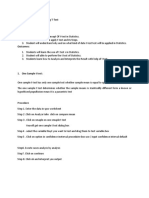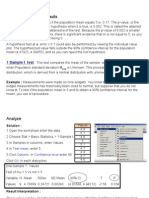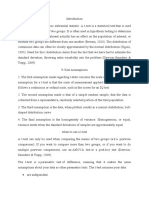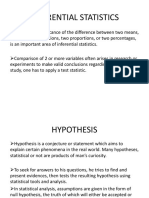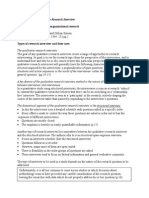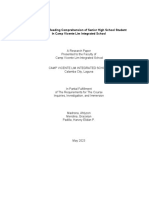Hypothesis Testing for two populations (Excel Tutorial)
Uploaded by
williamdugoHypothesis Testing for two populations (Excel Tutorial)
Uploaded by
williamdugoHypothesis Testing (two populations)
To conduct hypothesis test for two populations (difference between two population means), we can use
the Data Analysis Toolkit. This tool offers convenient options to perform this test. As learned in the
lecture, this hypothesis test can be categorized in one of three cases:
• CASE I: Population standard deviations 𝜎1 and 𝜎2 are known
• CASE II: Population standard deviations 𝜎1 and 𝜎2 are unknown but are assumed equal (𝜎1 = 𝜎2 )
• CASE III: Population standard deviations 𝜎1 and 𝜎2 are unknown and cannot be assumed equal
(𝜎1 ≠ 𝜎2 )
In all three cases, we will assume that we are conducting a hypothesis test on the difference between the
two population means (𝜇1 − 𝜇2 ) and we are testing in the alternative hypothesis that this difference is
either < or > or ≠ to a difference 𝑑0 .
CASE I: Population standard deviations 𝜎1 and 𝜎2 are known
To perform this test, we will open the Data Analysis Toolkit and,
1. Choose the “z-Test: Two Sample For Means” option from the menu.
2. Select in “Variable 1 Range” and “Variable 2 Range” the data for variables 1 and 2, respectively.
3. In the “Hypothesized Mean Difference” box enter 𝑑0 .
4. In the “Variable 1 Variance (known)” and “Variable 2 Variance (known)” boxes enter 𝜎1 and 𝜎2 ,
respectively.
5. Check the “Labels” box if the data you selected in step 2 contained the headers (labels).
6. In the Alpha box specify the required significance level of the test.
7. Specify the location of the output, and,
8. Hit Enter.
This will print the output at your specified location which contains:
• The sample averages (𝑥̅1 and 𝑥̅2 )
• The known population variances (𝜎12 and 𝜎12 )
• The sample sizes (𝑛1 and 𝑛2 )
• The hypothesized difference (𝑑0 )
• The test statistic (𝑧)
• The 𝑃(𝑍 ≤ 𝑧) and critical 𝑧 for one-tail and two-tailed tests.
Note: The two P(Z<=z) values provided are the p-values for the one-tailed and two-tailed tests.
Note: we did not specify if our test is one-tailed or two tailed. The Data Analysis tool provides the p-
value for both. Depending on our own test, we will use the relevant one.
Note: if your test is two-tailed, you do not need to multiply the probability provided under the two-tailed
test result. It is already multiplied by 2. The probability provided is the p-value for the two-tailed test.
Note: if the way you set up your competing hypotheses results in a hypothesized difference (𝑑0 ) that is
negative, you’d need to change the order of the populations so that you will end up with a positive
hypothesized difference (𝑑0 ). The Data Analysis Tool only accepts positive 𝑑0 .
Prepared by: Dr. Behrouz Bakhtiari DeGroote School of Business
CASE II: Population standard deviations 𝜎1 and 𝜎2 are unknown but are
assumed equal (𝜎1 = 𝜎2 )
To perform this test, we will open the Data Analysis Toolkit and,
1. Choose the “t-Test: Two-Sample Assuming Equal Variances” option from the menu.
2. Select in “Variable 1 Range” and “Variable 2 Range” the data for variables 1 and 2, respectively.
3. In the “Hypothesized Mean Difference” box enter 𝑑0 .
4. Check the “Labels” box if the data you selected in step 2 contained the headers (labels).
5. In the Alpha box specify the required significance level of the test.
6. Specify the location of the output, and,
7. Hit Enter.
This will print the output at your specified location which contains:
• The sample averages (𝑥̅1 and 𝑥̅2 )
• The sample variances (𝑠12 and 𝑠12 )
• The sample sizes (𝑛1 and 𝑛2 )
• The pooled variance (𝑠𝑝2 )
• The hypothesized difference (𝑑0 )
• The degree of freedom for the test statistic (𝑑𝑓)
Prepared by: Dr. Behrouz Bakhtiari DeGroote School of Business
• The test statistic (𝑡)
• The 𝑃(𝑇 ≤ 𝑡) and critical 𝑡 for one-tail and two-tailed tests.
Note: The two P(T<=t) values provided are the p-values for the one-tailed and two-tailed tests.
Note: we did not specify if our test is one-tailed or two tailed. The Data Analysis tool provides the p-
value for both. Depending on our own test, we will use the relevant one.
Note: if your test is two-tailed, you do not need to multiply the probability provided under the two-tailed
test result. It is already multiplied by 2. The probability provided is the p-value for the two-tailed test.
Note: if the way you set up your competing hypotheses results in a hypothesized difference (𝑑0 ) that is
negative, you’d need to change the order of the populations so that you will end up with a positive
hypothesized difference (𝑑0 ). The Data Analysis Tool only accepts positive 𝑑0 .
CASE III: Population standard deviations 𝜎1 and 𝜎2 are unknown and
cannot be assumed equal (𝜎1 ≠ 𝜎2 )
To perform this test, we will open the Data Analysis Toolkit and,
8. Choose the “t-Test: Two-Sample Assuming Unequal Variances” option from the menu.
9. Select in “Variable 1 Range” and “Variable 2 Range” the data for variables 1 and 2, respectively.
10. In the “Hypothesized Mean Difference” box enter 𝑑0 .
11. Check the “Labels” box if the data you selected in step 2 contained the headers (labels).
Prepared by: Dr. Behrouz Bakhtiari DeGroote School of Business
12. In the Alpha box specify the required significance level of the test.
13. Specify the location of the output, and,
14. Hit Enter.
This will print the output at your specified location which contains:
• The sample averages (𝑥̅1 and 𝑥̅2 )
• The sample variances (𝑠12 and 𝑠12 )
• The sample sizes (𝑛1 and 𝑛2 )
• The hypothesized difference (𝑑0 )
• The degree of freedom for the test statistic (𝑑𝑓)
• The test statistic (𝑡)
• The 𝑃(𝑇 ≤ 𝑡) and critical 𝑡 for one-tail and two-tailed tests.
Note: The two P(T<=t) values provided are the p-values for the one-tailed and two-tailed tests.
Note: we did not specify if our test is one-tailed or two tailed. The Data Analysis tool provides the p-
value for both. Depending on our own test, we will use the relevant one.
Note: if your test is two-tailed, you do not need to multiply the probability provided under the two-tailed
test result. It is already multiplied by 2. The probability provided is the p-value for the two-tailed test.
Note: if the way you set up your competing hypotheses results in a hypothesized difference (𝑑0 ) that is
negative, you’d need to change the order of the populations so that you will end up with a positive
hypothesized difference (𝑑0 ). The Data Analysis Tool only accepts positive 𝑑0 .
Prepared by: Dr. Behrouz Bakhtiari DeGroote School of Business
Exercises
You can download the Excel file for this example at this link.
We will practice performing hypothesis tests using two populations using data in Excel. See the Excel file
“Hypothesis Testing (two populations) for the data.
Question 1
A consumer advocate researches the length of life between two brands of refrigerators, Brand A and
Brand B. He collects data (measured in years) n the longevity of 40 refrigerators for Brand A and repeats
the sampling for Bran B. The data is provided in the tab “Longevity”. Suppose the researcher wants to
determine if the average life differs between Brand A and Brand B.
a) Specify the competing hypotheses.
b) Calculate the value of the test statistic as well as the p-value assuming 𝜎𝐴2 = 4.4 and 𝜎𝐵2 = 5.2.
c) At 5% significance level, what is the conclusion of the test?
Question 2
The “See Me” marketing agency wants to determine if time of day for television advertisement influences
website searches for a product. They have extracted the number of website searches occurring during a
one-hour period after an advertisement was aired for a random sample of 30 day and 30 evening
advertisements. The data is provided in the tab by the name “Searches”. Suppose an analyst wants to
determine if the average number of website searches differs between the day and evening advertisements.
a) specify the competing hypotheses.
b) Calculate the value of the test statistic and the p-value, assuming that the population variances are
equal.
c) What is the conclusion of the test at 5% significance level?
Question 3
In Question 2, you concluded that the mean number of searches between Day and Evening advertisements
differ. It is not hard to see that the mean number of searches after Evening advertisements is higher
(population 2). You would like to determine if the difference between the two averages is higher than
10,000 searches. In other words, you would like to investigate if the mean number of searches after
Evening advertisements is higher than that of the Day advertisements by more than 10,000. Conduct this
test in the “Searches Version 2” tab.
a) specify the competing hypotheses.
b) Calculate the value of the test statistic and the p-value, assuming that the population variances are
equal.
c) What is the conclusion of the test at 5% significance level?
Prepared by: Dr. Behrouz Bakhtiari DeGroote School of Business
You might also like
- Week 6 2-Sample Hypothesis Testing and CI Part2No ratings yetWeek 6 2-Sample Hypothesis Testing and CI Part29 pages
- Analysing and Presenting Data: Practical Hints: Daniele CEI, Giorgio MATTEINo ratings yetAnalysing and Presenting Data: Practical Hints: Daniele CEI, Giorgio MATTEI53 pages
- MATH03_CO6.1.1 Hypothesis Testing (Two Samples)No ratings yetMATH03_CO6.1.1 Hypothesis Testing (Two Samples)33 pages
- Unit 4B - 2 - STUDENTS - Hypotheses Testing For Two PopulationsNo ratings yetUnit 4B - 2 - STUDENTS - Hypotheses Testing For Two Populations26 pages
- Statistical Inferences About Two Populations: Learning ObjectivesNo ratings yetStatistical Inferences About Two Populations: Learning Objectives26 pages
- Chapter 05-Statistical Inference - FullNo ratings yetChapter 05-Statistical Inference - Full47 pages
- Performing Hypothesis Testing For One-Sample T-Tests in Excel 2016No ratings yetPerforming Hypothesis Testing For One-Sample T-Tests in Excel 20162 pages
- Practical Guide To Hypothesis Testing in Data Science 1616263956No ratings yetPractical Guide To Hypothesis Testing in Data Science 16162639562 pages
- Module 4A Two Sample Z-Test For Independent Groups - UpdatedNo ratings yetModule 4A Two Sample Z-Test For Independent Groups - Updated26 pages
- Eleven: Mcgraw-Hill/Irwin © 2005 The Mcgraw-Hill Companies, Inc., All Rights ReservedNo ratings yetEleven: Mcgraw-Hill/Irwin © 2005 The Mcgraw-Hill Companies, Inc., All Rights Reserved26 pages
- Two Sample T Test in Excel For Means: Overview: Step 1No ratings yetTwo Sample T Test in Excel For Means: Overview: Step 13 pages
- Sample Size for Analytical Surveys, Using a Pretest-Posttest-Comparison-Group DesignFrom EverandSample Size for Analytical Surveys, Using a Pretest-Posttest-Comparison-Group DesignNo ratings yet
- How to Find Inter-Groups Differences Using Spss/Excel/Web Tools in Common Experimental Designs: Book 1From EverandHow to Find Inter-Groups Differences Using Spss/Excel/Web Tools in Common Experimental Designs: Book 1No ratings yet
- How to Find Inter-Groups Differences Using Spss/Excel/Web Tools in Common Experimental Designs: Book TwoFrom EverandHow to Find Inter-Groups Differences Using Spss/Excel/Web Tools in Common Experimental Designs: Book TwoNo ratings yet
- Job Satisfaction and Employee Retention in The South African Police ServiceNo ratings yetJob Satisfaction and Employee Retention in The South African Police Service190 pages
- 655 - Risk Management: Advanced Diploma in InsuranceNo ratings yet655 - Risk Management: Advanced Diploma in Insurance26 pages
- Acoustically Induced Vibration (Aiv) & Flow Induced Vibration (Fiv) Analysis For The High Pressure Reducing Systems Using Energy Institute GuidelinesNo ratings yetAcoustically Induced Vibration (Aiv) & Flow Induced Vibration (Fiv) Analysis For The High Pressure Reducing Systems Using Energy Institute Guidelines4 pages
- DR Ritu: New Products From Market Research Kellogg'sNo ratings yetDR Ritu: New Products From Market Research Kellogg's11 pages
- Sexual Harassment at Workplace A Case of Banking Sector in LahoreNo ratings yetSexual Harassment at Workplace A Case of Banking Sector in Lahore9 pages
- Sample Concept Proposal in Social ScienceNo ratings yetSample Concept Proposal in Social Science6 pages
- JOURNAL OF SCIENCE, Hue University, N 61, 2010No ratings yetJOURNAL OF SCIENCE, Hue University, N 61, 201014 pages
- Physical Security Research Paper TemplateNo ratings yetPhysical Security Research Paper Template4 pages
- Analysing and Presenting Data: Practical Hints: Daniele CEI, Giorgio MATTEIAnalysing and Presenting Data: Practical Hints: Daniele CEI, Giorgio MATTEI
- Unit 4B - 2 - STUDENTS - Hypotheses Testing For Two PopulationsUnit 4B - 2 - STUDENTS - Hypotheses Testing For Two Populations
- Statistical Inferences About Two Populations: Learning ObjectivesStatistical Inferences About Two Populations: Learning Objectives
- Performing Hypothesis Testing For One-Sample T-Tests in Excel 2016Performing Hypothesis Testing For One-Sample T-Tests in Excel 2016
- Practical Guide To Hypothesis Testing in Data Science 1616263956Practical Guide To Hypothesis Testing in Data Science 1616263956
- Module 4A Two Sample Z-Test For Independent Groups - UpdatedModule 4A Two Sample Z-Test For Independent Groups - Updated
- Eleven: Mcgraw-Hill/Irwin © 2005 The Mcgraw-Hill Companies, Inc., All Rights ReservedEleven: Mcgraw-Hill/Irwin © 2005 The Mcgraw-Hill Companies, Inc., All Rights Reserved
- Two Sample T Test in Excel For Means: Overview: Step 1Two Sample T Test in Excel For Means: Overview: Step 1
- Sample Size for Analytical Surveys, Using a Pretest-Posttest-Comparison-Group DesignFrom EverandSample Size for Analytical Surveys, Using a Pretest-Posttest-Comparison-Group Design
- How to Find Inter-Groups Differences Using Spss/Excel/Web Tools in Common Experimental Designs: Book 1From EverandHow to Find Inter-Groups Differences Using Spss/Excel/Web Tools in Common Experimental Designs: Book 1
- How to Find Inter-Groups Differences Using Spss/Excel/Web Tools in Common Experimental Designs: Book TwoFrom EverandHow to Find Inter-Groups Differences Using Spss/Excel/Web Tools in Common Experimental Designs: Book Two
- Job Satisfaction and Employee Retention in The South African Police ServiceJob Satisfaction and Employee Retention in The South African Police Service
- 655 - Risk Management: Advanced Diploma in Insurance655 - Risk Management: Advanced Diploma in Insurance
- Acoustically Induced Vibration (Aiv) & Flow Induced Vibration (Fiv) Analysis For The High Pressure Reducing Systems Using Energy Institute GuidelinesAcoustically Induced Vibration (Aiv) & Flow Induced Vibration (Fiv) Analysis For The High Pressure Reducing Systems Using Energy Institute Guidelines
- DR Ritu: New Products From Market Research Kellogg'sDR Ritu: New Products From Market Research Kellogg's
- Sexual Harassment at Workplace A Case of Banking Sector in LahoreSexual Harassment at Workplace A Case of Banking Sector in Lahore








